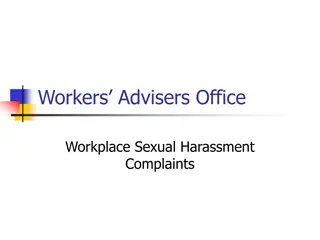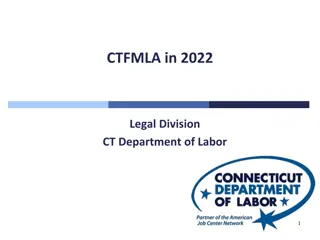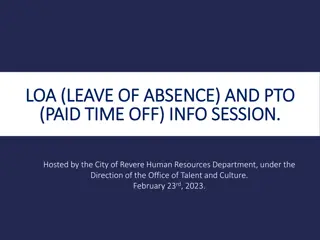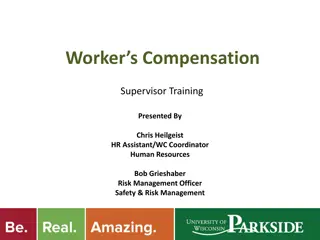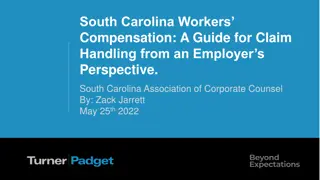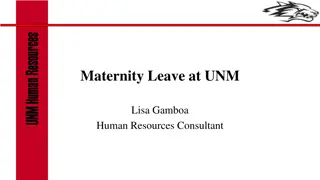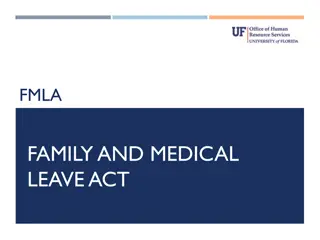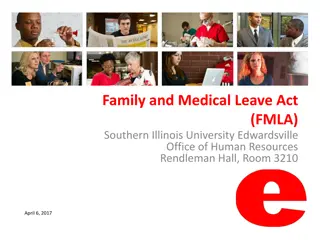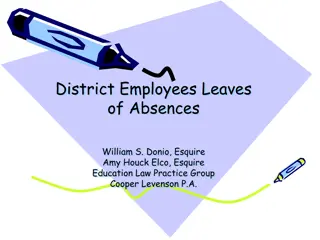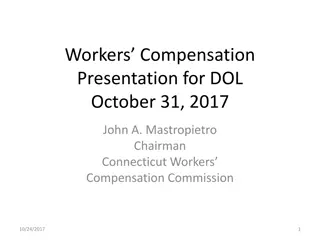Navigating the Bermuda Triangle of ADA, FMLA, and Workers' Compensation
Explore the complex interplay of the Americans with Disabilities Act (ADA), Family and Medical Leave Act (FMLA), and workers' compensation in the context of managing employee absences. Understand the importance of recognizing and analyzing how these laws intersect, potential violations, and employer responsibilities. Learn about the purposes and enforcement authorities of ADA, FMLA, and workers' compensation to ensure compliance and protect both employees and employers.
Download Presentation

Please find below an Image/Link to download the presentation.
The content on the website is provided AS IS for your information and personal use only. It may not be sold, licensed, or shared on other websites without obtaining consent from the author.If you encounter any issues during the download, it is possible that the publisher has removed the file from their server.
You are allowed to download the files provided on this website for personal or commercial use, subject to the condition that they are used lawfully. All files are the property of their respective owners.
The content on the website is provided AS IS for your information and personal use only. It may not be sold, licensed, or shared on other websites without obtaining consent from the author.
E N D
Presentation Transcript
Interplay of ADA, FMLA and Workers Compensation
WELCOME! 2
Introduction The Bermuda Triangle is an area in the Atlantic Ocean in which an unusually high number of ships and planes have disappeared. Because the interplay of three major employment laws the Americans with Disabilities Act (ADA), the Family and Medical Leave Act (FMLA) and workers compensation is so complicated and fraught with problems, many HR professionals often refer to these three laws as the Bermuda Triangle of employment law. 3
Agenda The importance of recognizing and analyzing the interplay of these laws. The purpose of each law. Enforcement authorities for each law. Important areas of interplay between the three laws that employers need to consider when managing employee absences. Example of an employee absence involving the interplay of the ADA, the FMLA and workers compensation. 4
The Importance of Recognizing and Analyzing the Interplay of These Laws Many unscheduled and scheduled absences are related to the illness of employees or their family members. One, two or all three of these laws may be involved. Violations of these laws may result in lost wages, back pay, reinstatement, retroactive benefits, compensatory damages and punitive damages. Other than the legal responsibilities, employers have moral and ethical responsibilities to ensure that employees receive the benefits and protections these laws provide. 5
The Purpose of the ADA The ADA (as amended) prohibits discrimination against applicants and employees who are qualified individuals with a disability, have a record of a disability, and those regarded as having a disability. The ADA also requires employers to provide reasonable accommodations to individuals with disabilities absent undue hardship. 7
The Purpose of the FMLA The FMLA provides employees with job protected leave for the following reasons: An employee s own serious health condition. To care for a family member with a serious health condition. The birth and care of a newborn child. The placement of a child for adoption or foster care. Certain military-related absences. 8
The Purpose of Workers Compensation State workers compensation laws provide for the payment of lost wages, medical expenses and rehabilitation for work-related injuries and illnesses. State workers compensation laws may also provide job protection and prohibit retaliation. Workers compensation is generally the sole remedy for an employee s work-related injury or illness. 9
Enforcement Authorities for the ADA, the FMLA and Workers Compensation Laws ADA: U.S. Equal Employment Opportunity Commission (EEOC) FMLA: U.S. Department of Labor (Wage and Hour Division) Workers compensation laws: state workers compensation commissions 11
Areas of Interplay Between the ADA, the FMLA and Workers Compensation There are areas of interplay between the ADA, the FMLA and workers compensation laws that employers need to consider when managing employee absenteeism. State laws may provide broader protections than federal requirements. Employer coverage: ADA: 15 or more employees for 20 weeks during the current or preceding calendar year. FMLA: 50 or more employees for at least 20 weeks during current or preceding calendar year. Workers compensation: Applies to most, even small, employers. State laws govern. 12
Areas of Interplay Between the ADA, the FMLA and Workers Compensation (cont.) Employee eligibility: ADA: An employee (or applicant) who is disabled, as defined by the ADA, is qualified for the position and can perform the essential functions of the position with or without a reasonable accommodation. FMLA: An employee who has worked at least 12 months and 1,250 hours before the start of the leave and who works at or reports to a worksite at which 50 or more employees work within a 75-mile radius. Workers compensation: An employee who has an injury or illness arising out of or in the course of employment, with state law exceptions possible for willful misconduct or intentional self-inflected injuries, willful disregard of safety rules, or intoxication from alcohol or illegal drugs. 13
Areas of Interplay Between the ADA, the FMLA and Workers Compensation (cont.) Length of leave: ADA: No specific limit for the amount of leave provided as a reasonable accommodation that does not create an undue hardship on the employer. FMLA: 12 weeks in the 12-month period as defined by the employer. 26 weeks of leave is provided for an employee to care for an injured servicemember. Workers compensation: No specific limit for the amount of leave an injured worker may have. 14
Areas of Interplay Between the ADA, the FMLA and Workers Compensation (cont.) Medical documentation: ADA: Only medical examinations or inquiries regarding an employee s disability that are job-related and limited to determining ability to perform the job and whether an accommodation is needed and would be effective. FMLA: Medical certification of the need for the leave, not to exceed what is requested on the U.S. Department of Labor (DOL) medical certification form. Workers compensation: Medical information that pertains to the employee s on- the-job injury. 15
Areas of Interplay Between the ADA, the FMLA and Workers Compensation (cont.) Restricted or light duty: ADA: Required to be offered if it is a reasonable accommodation that does not create an undue hardship on the employer. FMLA: Not applicable. FMLA covers absences from work only. Workers compensation: Recommended to be offered if available because it may reduce the employee s entitlement to the wage replacement benefit and lessen the impact of the claim. 17
Areas of Interplay Between the ADA, the FMLA and Workers Compensation (cont.) Fitness-to-return-to-work certification: ADA: Permitted as long as the medical examination and inquiry are job-related and necessary to determine whether the employee can perform the essential functions of the job. FMLA: May be required only under a policy or practice that requires employees who have been on a similar type of leave of absence to provide one. Workers compensation: May be and is typically required. 18
Areas of Interplay Between the ADA, the FMLA and Workers Compensation (cont.) Benefit continuation while on leave: ADA: No specific requirements but cannot discriminate and must provide the same benefits as those provided to employees on a non-ADA leave of absence. FMLA: Health coverage must be continued at the same level as before the leave. Benefits other than health benefits are determined by the employer s established policy for providing such benefits when the employee is on other forms of leave (paid or unpaid, as appropriate). Workers compensation: Not required to be continued unless it runs concurrently with FMLA leave. 19
Areas of Interplay Between the ADA, the FMLA and Workers Compensation (cont.) Reinstatement rights: ADA: Required reinstatement to previous job unless doing so would create an undue hardship on the employer. FMLA: Required reinstatement to the same or an equivalent job. No undue hardship exception. Workers compensation: No reinstatement rights under most state laws, except for retaliatory discharges. 20
Example: Employee Absence Involving the Interplay of the ADA, the FMLA and Workers Compensation Jade has been employed by ABC Manufacturing, a company with over 500 employees, for three years working full-time with very few absences. Jade calls in sick for three days, citing extreme back pain. Jade calls in sick for the fourth day stating that she was examined by her doctor who took X-rays and stated that she needs complete bed rest and possibly back surgery and will be unable to work for an extended period of time. Jade states that her doctor thinks the condition is caused by the type of work she has been doing. 22
Example (cont.) Using the areas of interplay between the ADA, the FMLA and workers compensation laws, here is an analysis of Jade s absence: Employer coverage. ABC Manufacturing is covered under and must comply with the ADA, the FMLA and the state workers compensation laws. Employee eligibility. Jade may be eligible for protection under the ADA and the FMLA, depending on the severity of her condition. A workers compensation claim must be filed and processed with the insurance carrier or administrator who will make a determination as to coverage under workers compensation. 23
Example (cont.) Length of leave. Leave as a reasonable accommodation under the ADA is not an issue at this point because Jade s absence, with proper medical certification, will be designated as FMLA leave. Should her absence exceed 12 weeks, additional leave may be required to be provided as a reasonable accommodation under the ADA. If the condition is determined to be work- related, workers compensation leave will run concurrently with the FMLA leave. Medical documentation. Under the ADA, no medical documentation is yet required. The employer may require FMLA medical certification. The workers compensation insurer will require medical documentation. 24
Example (cont.) Restricted or light duty. Not required at the present time because Jade is unable to work in any capacity until further notice. When she is able to return to work and if she has medical restrictions, the employer must offer light duty, if available, as a reasonable accommodation under the ADA unless this creates an undue hardship on the employer. Her employer may not require light duty if FMLA leave is still available. Light duty should be offered under workers compensation when appropriate. Fitness-to-return-to-work certification. Not required at the present time because Jade is unable to work in any capacity until further notice. When she is able to return to work, depending on any restrictions, the employer may require her to provide this certification under the ADA, the FMLA (if stated in the designation letter) and workers compensation. 25
Example (cont.) Benefits while on leave. Not required under the ADA. Under the FMLA, Jade s health benefits will be continued at the same level as before her leave, and she will receive other benefit continuation given for employees on similar non-FMLA leave. No additional benefit continuation under workers compensation is required in most states. Reinstatement. Jade must be reinstated to her previous job under the ADA unless doing so would create an undue hardship on her employer. If she can return to work before she exhausts her 12 weeks of FMLA leave, the employer must reinstate her in her previous or a similar position. Workers compensation does not provide for reinstatement under most state laws, except for retaliatory discharge. 26
Summary Employers need to recognize and evaluate the interplay of the ADA, the FMLA and workers compensation laws because many absences are related to the illness of employees or their family members, and one, two or all three laws may be involved. Employers have legal responsibilities to comply with these laws and face significant violations for noncompliance. Employers have ethical and moral responsibilities to ensure employees receive the benefits and protections these laws provide. 28
Summary (cont.) The three laws have different purposes. The ADA prohibits discrimination and requires reasonable accommodations. The FMLA sets minimum leave standards. Workers compensation laws provide for payment of compensation and rehabilitation for workplace injuries and minimize employer liability. The ADA is enforced by the EEOC, the FMLA by the DOL, and workers compensation laws by state workers compensation commissions 29
Summary (cont.) Important areas of interplay between the three laws are: Employer coverage. Employee eligibility. Length of leave. Medical documentation. Restricted or light duty. Fitness-to-return-to-work certification. Benefits while on leave. Reinstatement. 30
Training Evaluation Please complete the training evaluation sheet included in the handouts. Thank you for your interest and attention! 32



